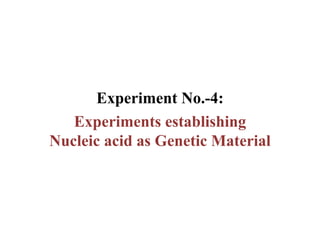
Molecular Biology Spots.pptx
- 1. Experiment No.-4: Experiments establishing Nucleic acid as Genetic Material
- 2. Griffith’s Experiment: Frederick Griffith (1928) Finding: Living R strain has been transformed into S strain ( transformation ) by an unknown substance. Griffith used two strains of Pneumococcus bacteria, type III-S and type II-R.
- 3. Avery’s experiment (1944) Oswald Avery, Colin MacLeod, and Maclyn McCarty
- 4. Finding: DNA is the substance that causes bacterial transformation Avery’s experiment (1944) Oswald Avery, Colin MacLeod, and Maclyn McCarty
- 5. Hershey and Chase Experiment (1952) Alfred D. Hershey and Martha Chase Bacteriophages (T2) produced within bacteria growing in radioactive culture medium will themselves be radioactive. If radioactive sulfur atoms (35S) are present, they will be incorporated into the protein coats of the bacteriophages since two of the amino acids – Cysteine and Methionine contain sulfur. If radioactive phosphorus (32P) is used instead, the DNA become radioactive — because of its many phosphorus atoms — but not the proteins.
- 6. Finding: This result reinforced the notion that DNA (and not the protein) is the genetic material. Hershey and Chase Experiment (1952) Alfred D. Hershey and Martha Chase
- 7. Two RNA-containing viruses were used in this experiment: tobacco mosaic virus (TMV), which infects the leaves of tobacco leaves, and Holmes ribgrass virus (HRV), which infects grass. The protein can be separated from the RNA by a simple chemical treatment. When this is done, the isolated RNA is infective, while the protein is not, suggesting that RNA is the hereditary material of these viruses. Fraenkel-Conrat Experiment (1957) H. Fraenkel Conrat and R.Williams
- 8. Meselson & Stahl’s Experiment (1952) Matthew Meselson & Frank Stahl Proposed by Watson and Crick Proposed by Max Delbrück
- 9. Meselson & Stahl’s Experiment (1952) Matthew Meselson & Frank Stahl
- 10. Spots for Experiment no. 7: Study of structures of : tRNA (2D and 3D); Prokaryotic RNA polymerase, and Eukaryotic RNA polymerase II through photographs
- 11. Structure of tRNA (2D and 3D)